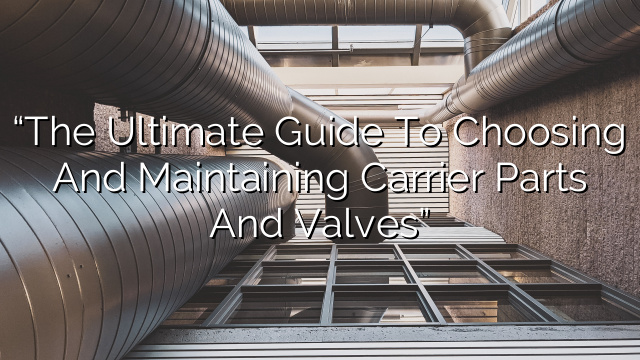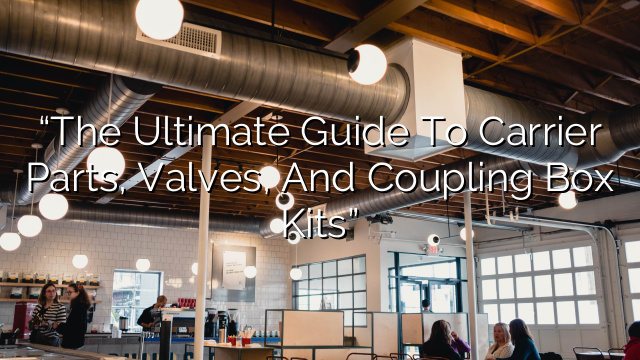Introduction
Welcome to “The Ultimate Guide to Choosing and Maintaining Carrier Parts and Valves”. Carrier is a well-known and reliable brand in the HVAC industry, and if you own a Carrier furnace or HVAC system, it’s important to understand the various parts and valves that make up the system. In this guide, we will walk you through the different types of Carrier parts and valves, their functions, and provide tips on how to choose and maintain them for optimal performance and longevity.
Types of Carrier Parts
Carrier offers a wide range of parts for their furnaces and HVAC systems. Here are some of the most common types of Carrier parts:
- Igniters: The igniter is responsible for lighting the burners in a Carrier furnace. It is a crucial component that ensures proper ignition of the fuel and stable operation of the furnace.
- Blower Motors and Wheels: These parts are responsible for circulating air through the system. Blower motors provide the power to spin the blower wheels, which push the air through the ducts. Regular maintenance and cleaning are essential to ensure maximum airflow and efficiency.
- Pressure Switches: Pressure switches ensure that there is proper airflow in the furnace. They monitor the pressure in the system and prevent the furnace from operating if the pressure is too high or too low. Regular inspection and replacement of faulty pressure switches are necessary to avoid safety issues.
- Thermostats: Thermostats are the control centers of HVAC systems. They allow you to set the desired temperature and control the operation of the heating and cooling systems. Carrier offers a range of programmable thermostats that provide energy-saving features and improved comfort.
- Limit Switches: Limit switches protect the furnace from overheating by shutting off the burner if the temperature exceeds a certain limit. Regular inspection and replacement of faulty limit switches are crucial for the safe operation of the furnace.
Types of Carrier Valves
In addition to parts, Carrier also offers various types of valves that are essential for the operation of HVAC systems. Here are the most common types of Carrier valves:
- Gas Valves: Gas valves control the flow of natural gas or propane to the burners in a furnace. Carrier gas valves are designed to provide precise control and ensure safe operation.
- Water Valves: Water valves control the flow of water in hydronic heating systems. They are essential for regulating the temperature and ensuring efficient heat transfer.
- Expansion Valves: Expansion valves are used in air conditioning systems to regulate the flow of refrigerant. They control the pressure and temperature of the refrigerant, allowing for efficient heat transfer and cooling.
- Zone Valves: Zone valves are used in HVAC systems with multiple zones to control the flow of air or water to each zone. They allow for individual temperature control and energy savings.
- Solenoid Valves: Solenoid valves are electromechanical valves that control the flow of fluids. They are commonly used in refrigerant systems and provide efficient and accurate control.
Choosing the Right Carrier Parts and Valves
When choosing Carrier parts and valves for your furnace or HVAC system, there are several factors to consider:
- Compatibility: Ensure that the parts and valves you choose are compatible with your specific Carrier model. Refer to the manufacturer’s guidelines or consult with a professional if you are unsure.
- Quality: Carrier is known for its high-quality products. Opt for genuine Carrier parts and valves to ensure reliability and longevity.
- Functionality: Consider the specific function of the part or valve you need. For example, if you are looking for a gas valve, choose one that provides precise control and meets safety standards.
- Budget: Set a budget for your repairs or upgrades and choose parts and valves that fit within your budget. Keep in mind that investing in quality components can save you money in the long run by minimizing the need for repairs and improving energy efficiency.
- Professional Assistance: If you are not confident in selecting the right parts or valves for your system, it is always recommended to seek professional assistance. HVAC technicians have the knowledge and experience to ensure proper selection and installation.
Maintaining Carrier Parts and Valves
Proper maintenance is crucial for the efficient and reliable operation of Carrier parts and valves. Here are some essential maintenance tips:
- Regular Inspection: Inspect all parts and valves regularly for signs of wear, corrosion, or damage. Replace any faulty or worn-out components promptly.
- Cleanliness: Keep all parts and valves clean and free from debris or obstructions. Regularly clean the blower wheel, filters, and other components to ensure maximum airflow and efficiency.
- Professional Maintenance: Schedule regular maintenance visits with a qualified HVAC technician. They can perform comprehensive inspections, cleanings, and tune-ups to keep your system in optimal condition.
- Follow Manufacturer’s Guidelines: Always refer to the manufacturer’s guidelines for maintenance instructions and recommended intervals. Following these guidelines can help prevent premature failure and ensure warranty coverage.
FAQs
Q: Can I use generic parts and valves instead of Carrier brand? A: While generic parts and valves may be available at a lower cost, it is always recommended to use genuine Carrier components for optimal compatibility, performance, and warranty coverage.
Q: How often should I replace the igniter in my Carrier furnace? A: The igniter should be replaced when it becomes weak or fails to ignite the burners consistently. Consult the manufacturer’s guidelines or seek professional advice for specific replacement intervals.
Q: Can I clean the blower wheel myself? A: It is possible to clean the blower wheel yourself, but it is recommended to have it cleaned by a professional during regular maintenance visits. They have the necessary tools and expertise to perform a thorough cleaning without causing damage.
Q: Are there any safety precautions I should take when maintaining Carrier parts and valves? A: Always turn off the power to the system before performing any maintenance or repairs. If you are unsure or uncomfortable with any task, it is best to consult a qualified HVAC technician to ensure safety and proper handling.
Q: Can I install Carrier parts and valves myself? A: Some maintenance tasks, such as changing filters or cleaning components, can be done by homeowners. However, for more complex tasks like installing new parts or valves, it is recommended to have a professional HVAC technician perform the installation to ensure proper and safe operation.
Conclusion
Choosing and maintaining the right Carrier parts and valves are essential for the efficient and reliable operation of your furnace or HVAC system. By understanding the different types of parts and valves available and following proper maintenance practices, you can ensure optimal performance and longevity of your Carrier system. Remember to consult the manufacturer’s guidelines and seek professional assistance when needed for a worry-free HVAC experience.


